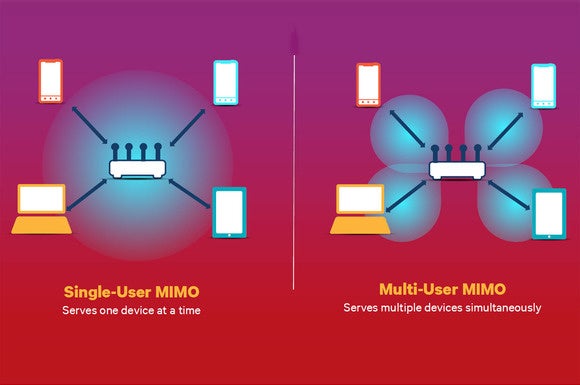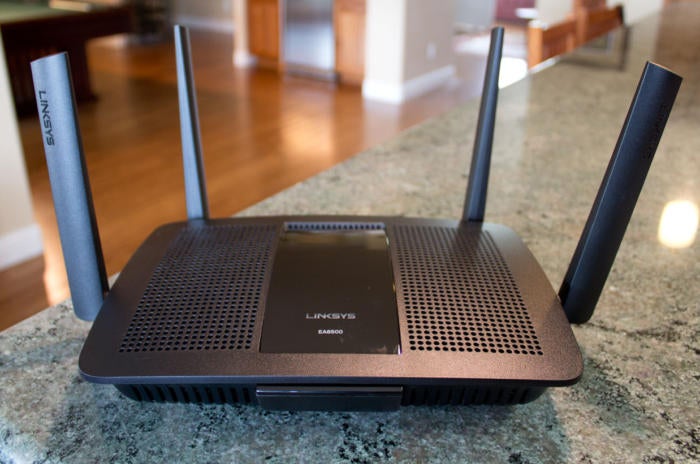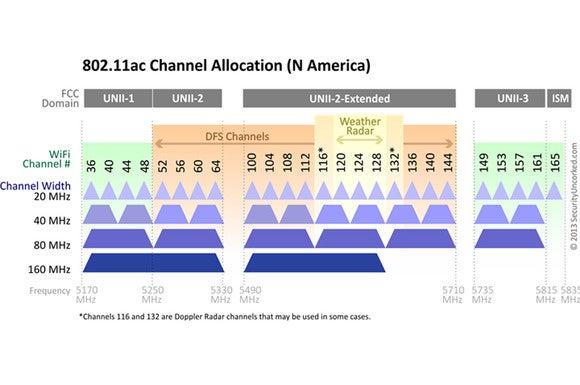
None of the many advancements to Wi-Fi over the past decade compare to the potential of this emerging technology. It’s one of the most complex and beneficial enhancements yet, because it enables Wi-Fi routers to do something they never could before: simultaneously send data to multiple devices.
Instead of your phone, streaming TV, and laptop taking turns receiving transmissions or downloads from the router, they may all in the future be able to simultaneously download or stream from the Internet. Though it may appear this is the case now, it’s not. You don’t really notice that the router is taking turns serving each device, other than perhaps seeing the effects, such as slower downloads and choppy video streams.
Understanding MIMO
Back in 2007, when the 802.11n wireless standard came to market, the single-user multiple-input and multiple-output (SU-MIMO) technology came with it. This allowed Wi-Fi routers and devices to simultaneously transmit or receive multiple streams of data between each other, increasing the speed of the connection.
A 1×1 router or client adapter supports by one transmit stream and one receive stream. A 2×2 device supports two streams in each direction, and a 3×3 device supports three. Any device that supports more streams will work with any device that supports less (and vice versa), but overall performance will be limited by the less device. And regardless of the number of streams an 802.11n router can support, it can communicate with only one device at a time.
SU-MIMO also requires the Wi-Fi devices to have multiple antennas in order to support the sending and recieving of multiple streams. The majority of Wi-Fi devices—especially in phones and tablets—are 1×1 devices, because the additional antennas and signal processing requires more space and power in the mobile devices, which adds extra cost and requires more power from the battery.
 Qualcomm
QualcommThis illustration shows how SU-MIMO can only communicate with devices individually, whereas MU-MIMO allows simultaneous communication with multiple devices.
Using multi-user multiple-input, multiple-output (MU-MIMO) technology, a wireless routers can transmit to and receive data from multiple Wi-Fi devices at the same time. Although the devices must also support MU-MIMO to utilize it, they aren’t required to have multiple antennas. Nor do they need to perform as much signal processing as SU-MIMO requires.
Benefits of MU-MIMO
Each new wireless standard released in the past (802.11b, 802.11g, 802.11a, 802.11n, and 802.11ac) has increased Wi-Fi speed. MU-MIMO was introduced with as an optional feature of the 802.11ac standard, so it wasn’t included in the first generation of 802.11ac routers to come to market. Even today, you’ll find MU-MIMO enabled in just one retail 802.11ac router, the Linksys EA8500.
In addition to making your network faster, MU-MIMO can aid in increasing its capacity. This means your home network could be able to handle more Wi-Fi devices. Networks with a dense number of users in an area, such as public Wi-Fi hotspots, should do better as well.
It’s important to note that even non-MIMO devices can see indirect improvements resulting from MU-MIMO. If MU-MIMO devices on the network are served more quickly, there’s inadvertently more time for SU-MIMO and other devices to communicate with the router.
Another difference from previous wireless standards and technologies is that the transmit beamforming used with MU-MIMO is standardized much better with 802.11ac than we saw with 802.11n and SU-MIMO. This means that products from different manufacturers will all support the same MU-MIMO and beamforming methods.
As mentioned, MU-MIMO doesn’t require such sophisticated Wi-Fi devices like SU-MIMO does. Since the multi-user method is less taxing on the devices and is cheaper to implement, we’ll likely see more devices support it than we have with the single-user method. The more MU-MIMO devices we see, the better the impact the technology will have on Wi-Fi networks.
 Michael Brown
Michael BrownThe Linksys EA8500 is currently the only Wi-Fi router that supports MU-MIMO out of the box.
One beneficial side-effect of MU-MIMO, at least for the time being, is that the data sent from the router to the Wi-Fi devices is unreadable by any other device or person. Only the indented recipient can process and read the data from the signal. Thus all the MU-MIMO traffic sent from the router to devices is essentially encrypted, unless at a later date a special tool is developed that can process such signals.
All channel widths supported
Wi-Fi networks operate on 5GHz of radio frequency spectrum. It’s considered unlicensed spectrum, because you don’t need a license to make use of it. Unlicensed, however, doesn’t mean unregulated. Government agencies (the FCC in the U.S.) regulate how radio frequencies are used because they’re used for a variety of sometimes competing purposes. But one of the most significant advantages of operating in 5GHz spectrum is the number of non-overlapping channels, each of which is 20MHz wide.
A Wi-Fi router can bond channels together to increase the amount of data that can be carried over the network. The 802.11ac routers on the market today use channel bonding to create channels that are 80MHz wide, but in that scenario the number of non-overlapping channels is reduced from 25 to just 6. The 802.11ac standard also permits using channels that are up to 160MHz wide, but this further reduces the number of non-overlapping channels to just two.
In environments where many Wi-Fi networks are operating, such as an apartment building or an office building, you could see significant network congestion as all the devices compete for the same limited bandwidth. Fortunately, the architects of the 802.11ac foresaw this problem and included provisions in the standard where an 802.11ac network will automatically fall back to using narrower channel widths in the presence of interference or noise that impacts only a portion of the wider channel.
 Qualcomm
QualcommThere are more non-overlapping channels available on the 5GHz frequency band, but their number shrinks as the individual channels become wider.
Caveats and requirements
The biggest caveat of MU-MIMO is that it works only on the downlink connection: traffic being sent from the router to your laptop, tablet, smartphone, and other Wi-Fi devices. MU-MIMO doesn’t directly improve the wireless speeds of uplink connections: traffic flowing to the router (such as an upload to the Internet).
It’s also worth repeating here that the only way to gain the full benefit of MU-MIMO is when the technology is supported on both the router and the device that’s connecting to the router. So in addition to having an 802.11ac adapter onboard, the client must explicitly support MU-MIMO—and there are precious few adapters meeting that criteria today.
Finally, MU-MIMO works best with stationary Wi-Fi devices. If you’re walking around your home while watching a video on your smartphone or tablet, you’re not going to get the full benefit of MU-MIMO even if that device supports it. Your router might even limit that connection to using SU-MIMO, so that the connection doesn’t negatively impact stronger MU-MIMO connections.
Getting your hands on MU-MIMO products
To date there are only a few MU-MIMO products publically available, such as the Linksys EA8500 router and Acer’s Aspire E-series laptops. A number of routers based on Quentenna’s QSR1000 chipset—including the Asus RT-AC87U and the Netgear Nighthawk X4—also support MU-MIMO, but they lack the firmware needed to activate the feature. Qualcomm reports that it’s slipped MU-MIMO support into some of its chipsets, however, so there could be many more devices in the wild that are just a firmware update away from supporting MU-MIMO support.
As with most emerging technologies, however, it could take some time before manufacturers learn how to make the most of of MU-MIMO. When TechHive compared the Linksys EA8500 to so-called tri-band SU-MIMO routers that operate three independent networks, a tri-band routers outperformed the MU-MIMO router in many scenarios. Time will tell which approach is best.


